Applied AC and DC Machines: DC Motors Report - First Year
VerifiedAdded on 2022/01/17
|15
|1933
|121
Report
AI Summary
This report provides a comprehensive analysis of DC motors, encompassing their classifications, construction, characteristics, operation, and performance specifications. The report begins by outlining the four main types of DC motors: permanent magnet, series, shunt, and compound motors, detailing their unique features and applications. It then delves into the construction of DC motors, describing the stator and rotor components, including the yoke, field windings, interpoles, compensating winding, brushes, armature core, armature winding, commutator, and shaft. The report further explores the characteristics of DC shunt, series, and compound motors, examining their torque-armature current, speed-armature current, and speed-torque characteristics. Additionally, it explains the different operation modes of DC motors, including externally-excited, shunt, series, and compounded configurations. Finally, the report concludes by discussing DC motor performance parameters such as speed, torque, and operating voltage, and how these specifications are related to the application of the motor. The report also provides references to support the information presented.
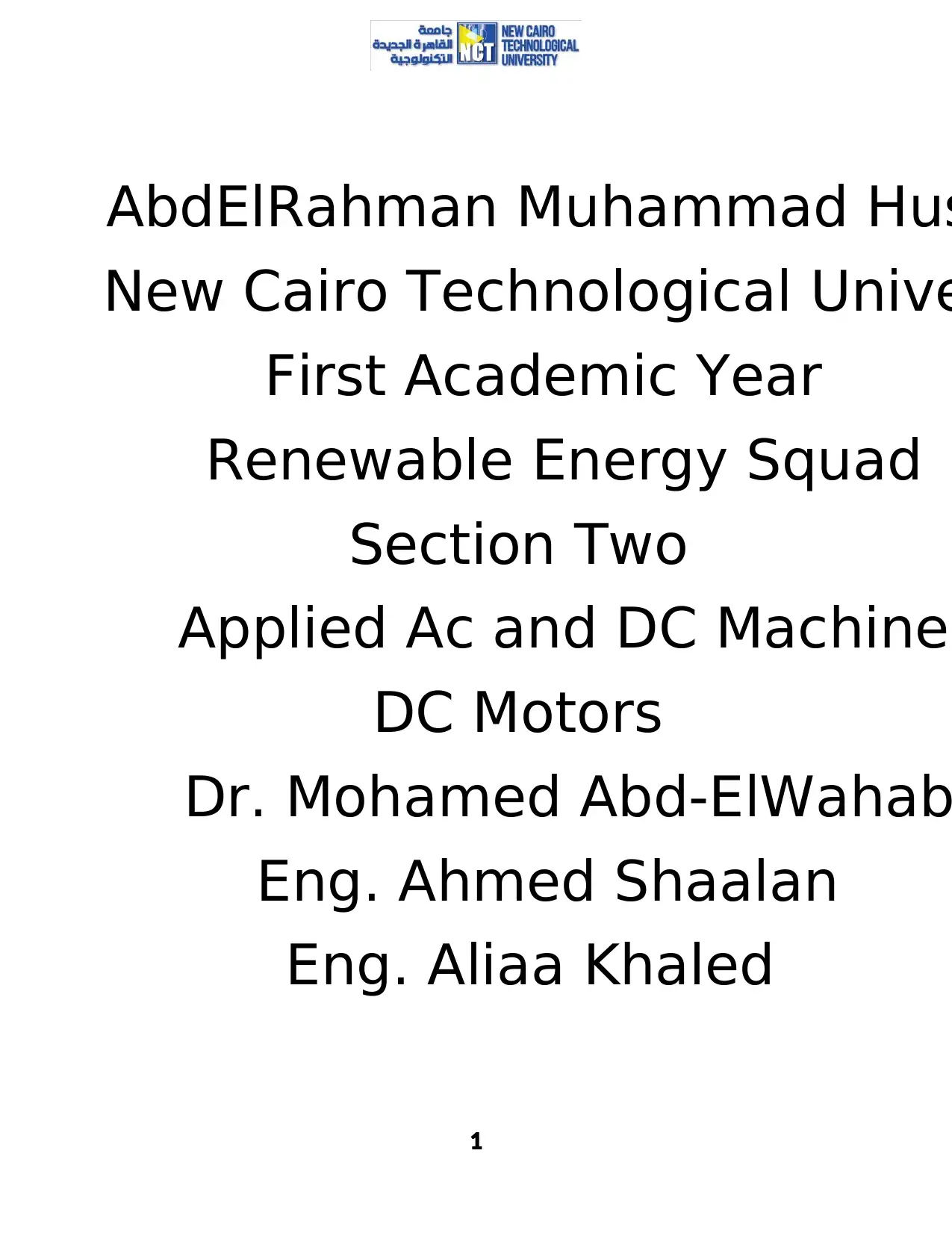
1
AbdElRahman Muhammad Hus
New Cairo Technological Unive
First Academic Year
Renewable Energy Squad
Section Two
Applied Ac and DC Machines
DC Motors
Dr. Mohamed Abd-ElWahab
Eng. Ahmed Shaalan
Eng. Aliaa Khaled
AbdElRahman Muhammad Hus
New Cairo Technological Unive
First Academic Year
Renewable Energy Squad
Section Two
Applied Ac and DC Machines
DC Motors
Dr. Mohamed Abd-ElWahab
Eng. Ahmed Shaalan
Eng. Aliaa Khaled
Paraphrase This Document
Need a fresh take? Get an instant paraphrase of this document with our AI Paraphraser
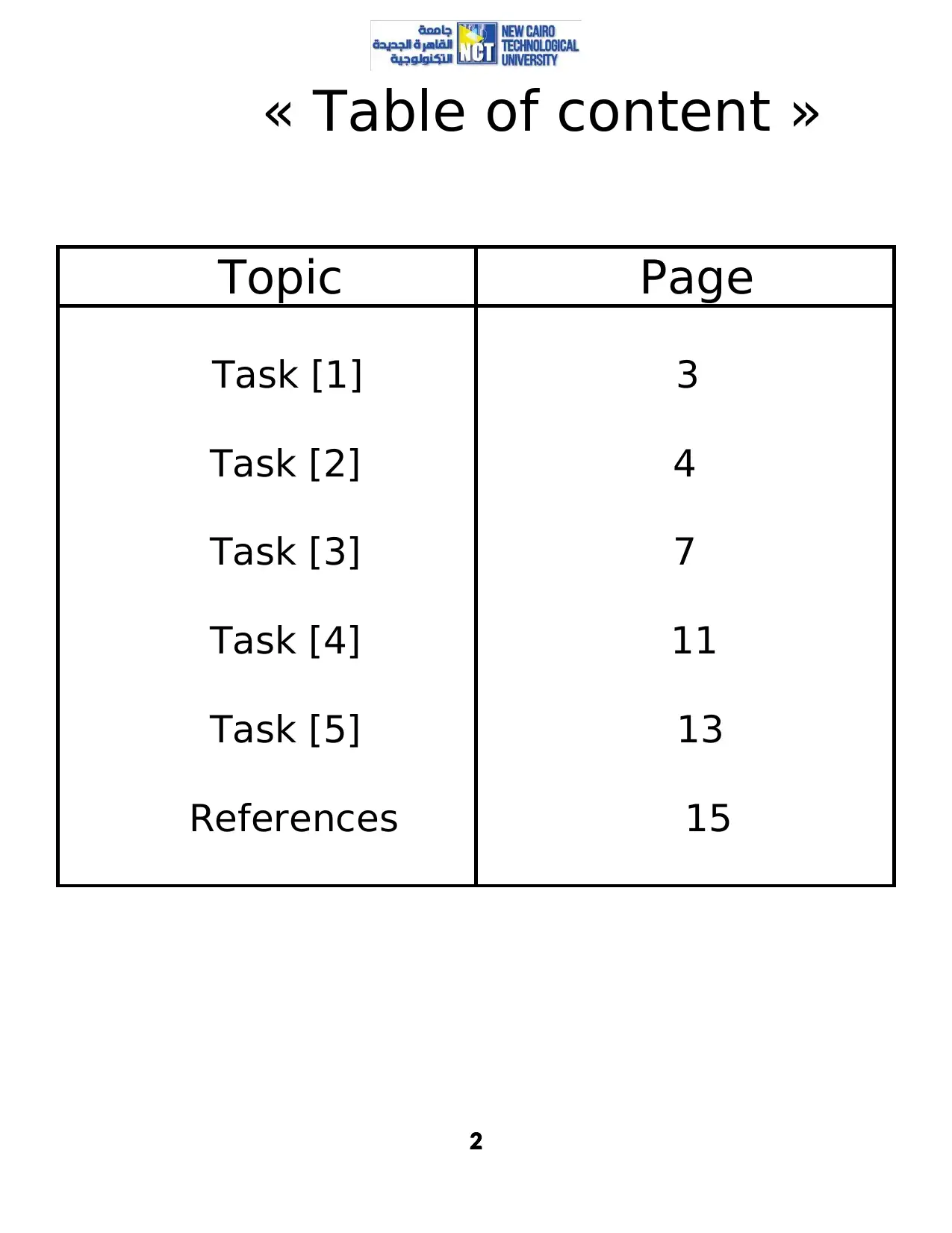
2
« Table of content »
Topic Page
Task [1]
Task [2]
Task [3]
Task [4]
Task [5]
References
3
4
7
11
13
15
« Table of content »
Topic Page
Task [1]
Task [2]
Task [3]
Task [4]
Task [5]
References
3
4
7
11
13
15
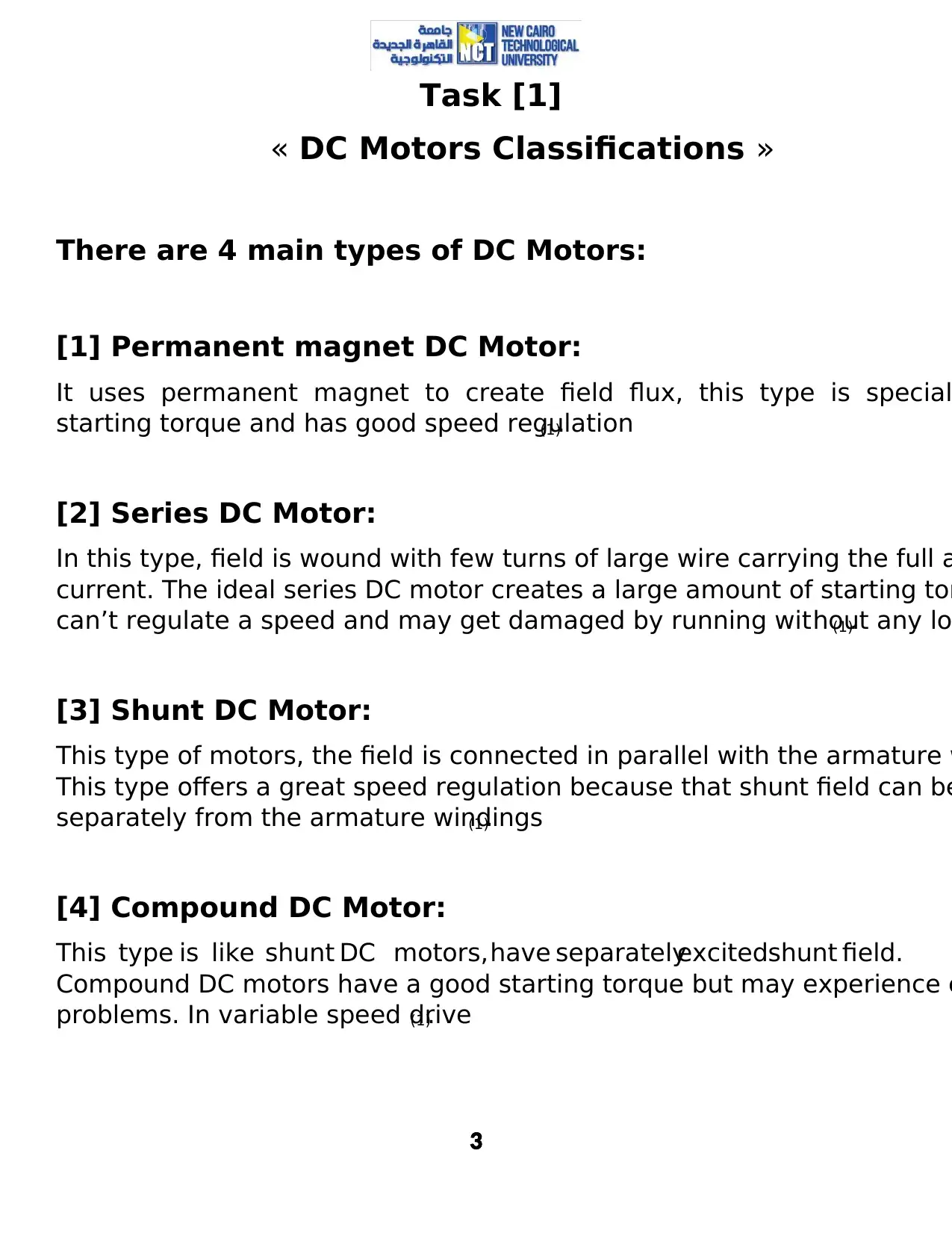
3
Task [1]
« DC Motors Classifications »
There are 4 main types of DC Motors:
[1] Permanent magnet DC Motor:
It uses permanent magnet to create field flux, this type is special
starting torque and has good speed regulation(1).
[2] Series DC Motor:
In this type, field is wound with few turns of large wire carrying the full a
current. The ideal series DC motor creates a large amount of starting tor
can’t regulate a speed and may get damaged by running without any lo(1).
[3] Shunt DC Motor:
This type of motors, the field is connected in parallel with the armature w
This type offers a great speed regulation because that shunt field can be
separately from the armature windings(1).
[4] Compound DC Motor:
This type is like shunt DC motors, have separatelyexcitedshunt field.
Compound DC motors have a good starting torque but may experience c
problems. In variable speed drive(1).
Task [1]
« DC Motors Classifications »
There are 4 main types of DC Motors:
[1] Permanent magnet DC Motor:
It uses permanent magnet to create field flux, this type is special
starting torque and has good speed regulation(1).
[2] Series DC Motor:
In this type, field is wound with few turns of large wire carrying the full a
current. The ideal series DC motor creates a large amount of starting tor
can’t regulate a speed and may get damaged by running without any lo(1).
[3] Shunt DC Motor:
This type of motors, the field is connected in parallel with the armature w
This type offers a great speed regulation because that shunt field can be
separately from the armature windings(1).
[4] Compound DC Motor:
This type is like shunt DC motors, have separatelyexcitedshunt field.
Compound DC motors have a good starting torque but may experience c
problems. In variable speed drive(1).
⊘ This is a preview!⊘
Do you want full access?
Subscribe today to unlock all pages.

Trusted by 1+ million students worldwide
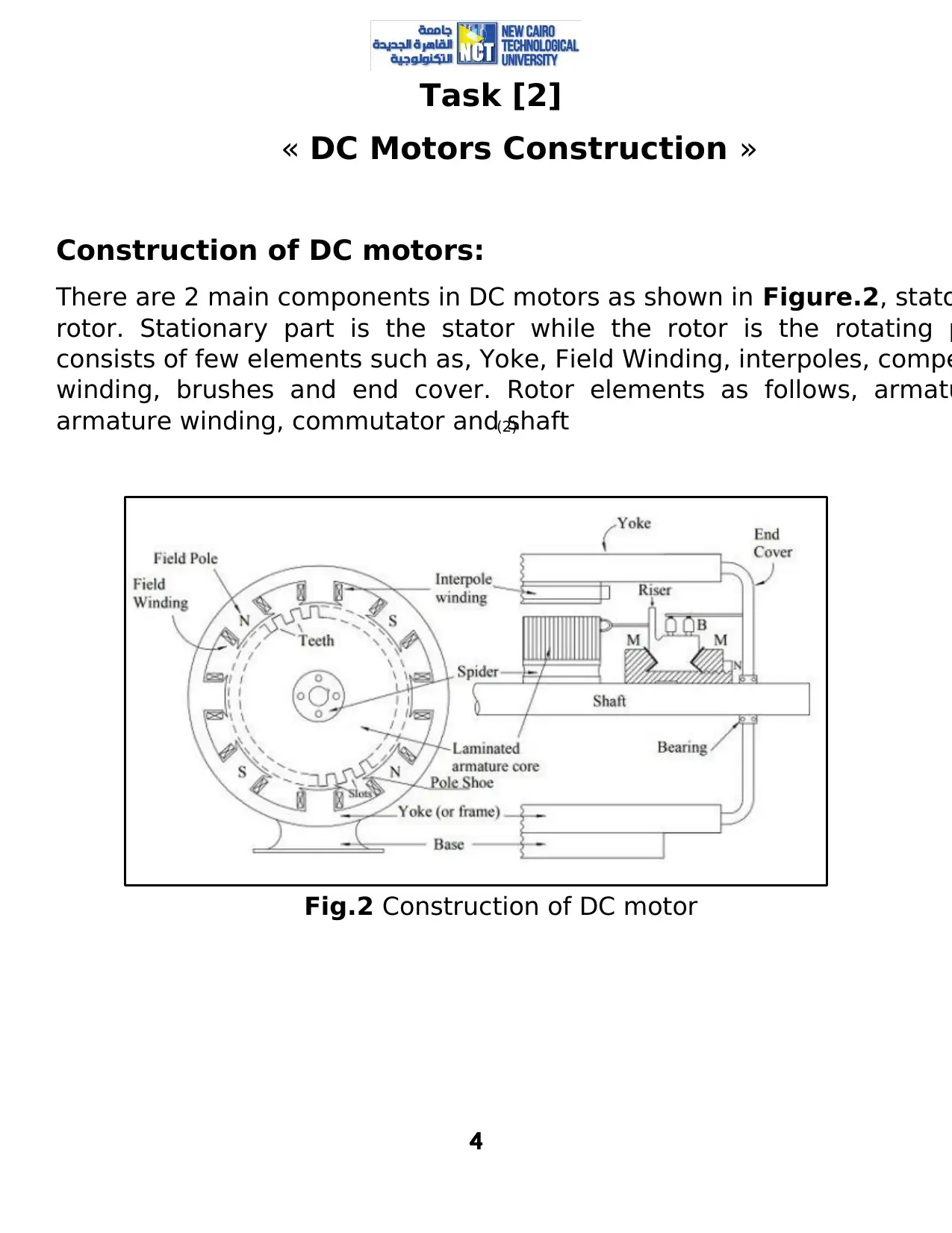
4
Task [2]
« DC Motors Construction »
Construction of DC motors:
There are 2 main components in DC motors as shown in Figure.2, stato
rotor. Stationary part is the stator while the rotor is the rotating p
consists of few elements such as, Yoke, Field Winding, interpoles, compe
winding, brushes and end cover. Rotor elements as follows, armatu
armature winding, commutator and shaft(2).
Fig.2 Construction of DC motor
Task [2]
« DC Motors Construction »
Construction of DC motors:
There are 2 main components in DC motors as shown in Figure.2, stato
rotor. Stationary part is the stator while the rotor is the rotating p
consists of few elements such as, Yoke, Field Winding, interpoles, compe
winding, brushes and end cover. Rotor elements as follows, armatu
armature winding, commutator and shaft(2).
Fig.2 Construction of DC motor
Paraphrase This Document
Need a fresh take? Get an instant paraphrase of this document with our AI Paraphraser
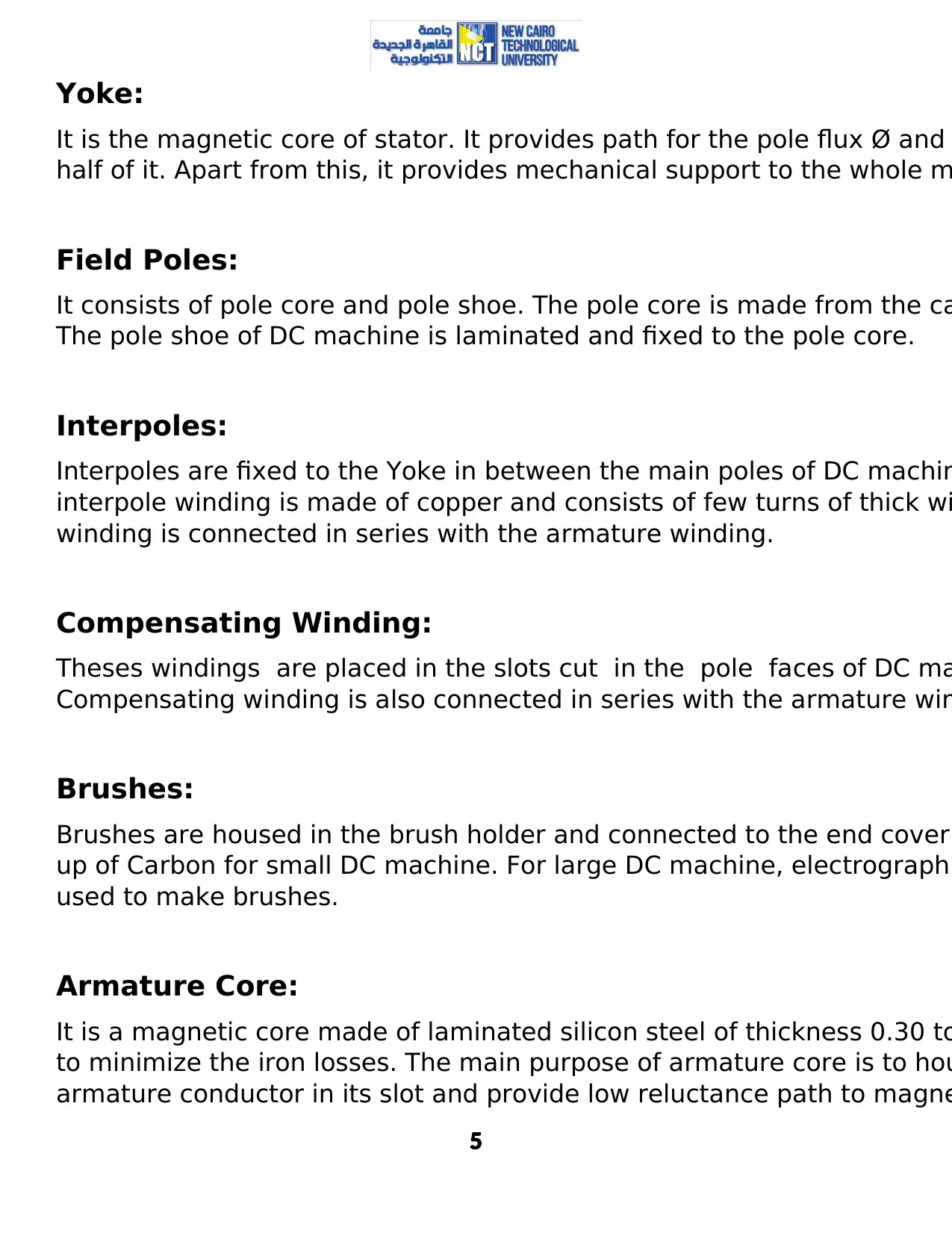
5
Yoke:
It is the magnetic core of stator. It provides path for the pole flux Ø and
half of it. Apart from this, it provides mechanical support to the whole m
Field Poles:
It consists of pole core and pole shoe. The pole core is made from the ca
The pole shoe of DC machine is laminated and fixed to the pole core.
Interpoles:
Interpoles are fixed to the Yoke in between the main poles of DC machin
interpole winding is made of copper and consists of few turns of thick wi
winding is connected in series with the armature winding.
Compensating Winding:
Theses windings are placed in the slots cut in the pole faces of DC ma
Compensating winding is also connected in series with the armature win
Brushes:
Brushes are housed in the brush holder and connected to the end cover.
up of Carbon for small DC machine. For large DC machine, electrographi
used to make brushes.
Armature Core:
It is a magnetic core made of laminated silicon steel of thickness 0.30 to
to minimize the iron losses. The main purpose of armature core is to hou
armature conductor in its slot and provide low reluctance path to magne
Yoke:
It is the magnetic core of stator. It provides path for the pole flux Ø and
half of it. Apart from this, it provides mechanical support to the whole m
Field Poles:
It consists of pole core and pole shoe. The pole core is made from the ca
The pole shoe of DC machine is laminated and fixed to the pole core.
Interpoles:
Interpoles are fixed to the Yoke in between the main poles of DC machin
interpole winding is made of copper and consists of few turns of thick wi
winding is connected in series with the armature winding.
Compensating Winding:
Theses windings are placed in the slots cut in the pole faces of DC ma
Compensating winding is also connected in series with the armature win
Brushes:
Brushes are housed in the brush holder and connected to the end cover.
up of Carbon for small DC machine. For large DC machine, electrographi
used to make brushes.
Armature Core:
It is a magnetic core made of laminated silicon steel of thickness 0.30 to
to minimize the iron losses. The main purpose of armature core is to hou
armature conductor in its slot and provide low reluctance path to magne
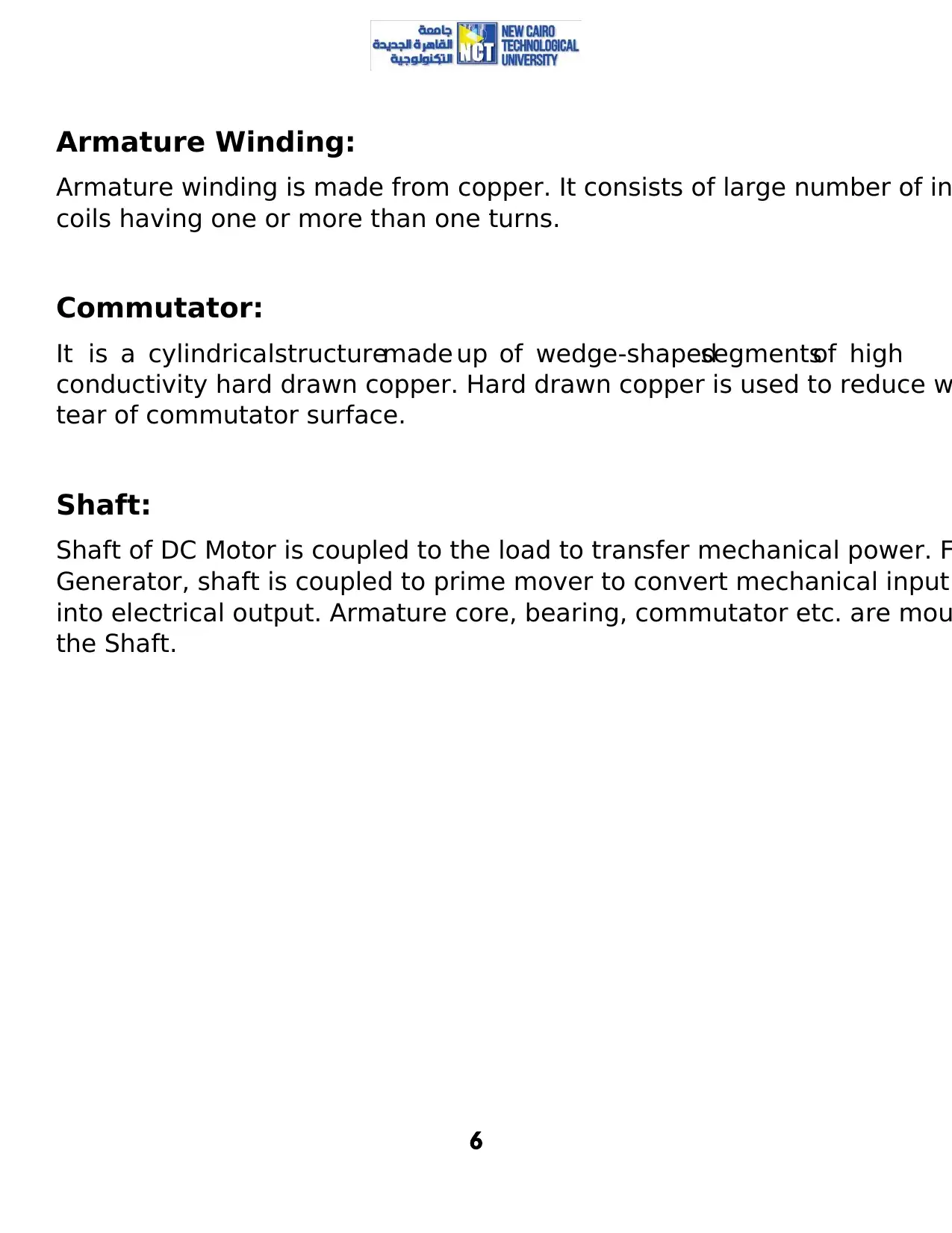
6
Armature Winding:
Armature winding is made from copper. It consists of large number of in
coils having one or more than one turns.
Commutator:
It is a cylindricalstructuremade up of wedge-shapedsegmentsof high
conductivity hard drawn copper. Hard drawn copper is used to reduce w
tear of commutator surface.
Shaft:
Shaft of DC Motor is coupled to the load to transfer mechanical power. F
Generator, shaft is coupled to prime mover to convert mechanical input
into electrical output. Armature core, bearing, commutator etc. are mou
the Shaft.
Armature Winding:
Armature winding is made from copper. It consists of large number of in
coils having one or more than one turns.
Commutator:
It is a cylindricalstructuremade up of wedge-shapedsegmentsof high
conductivity hard drawn copper. Hard drawn copper is used to reduce w
tear of commutator surface.
Shaft:
Shaft of DC Motor is coupled to the load to transfer mechanical power. F
Generator, shaft is coupled to prime mover to convert mechanical input
into electrical output. Armature core, bearing, commutator etc. are mou
the Shaft.
⊘ This is a preview!⊘
Do you want full access?
Subscribe today to unlock all pages.

Trusted by 1+ million students worldwide
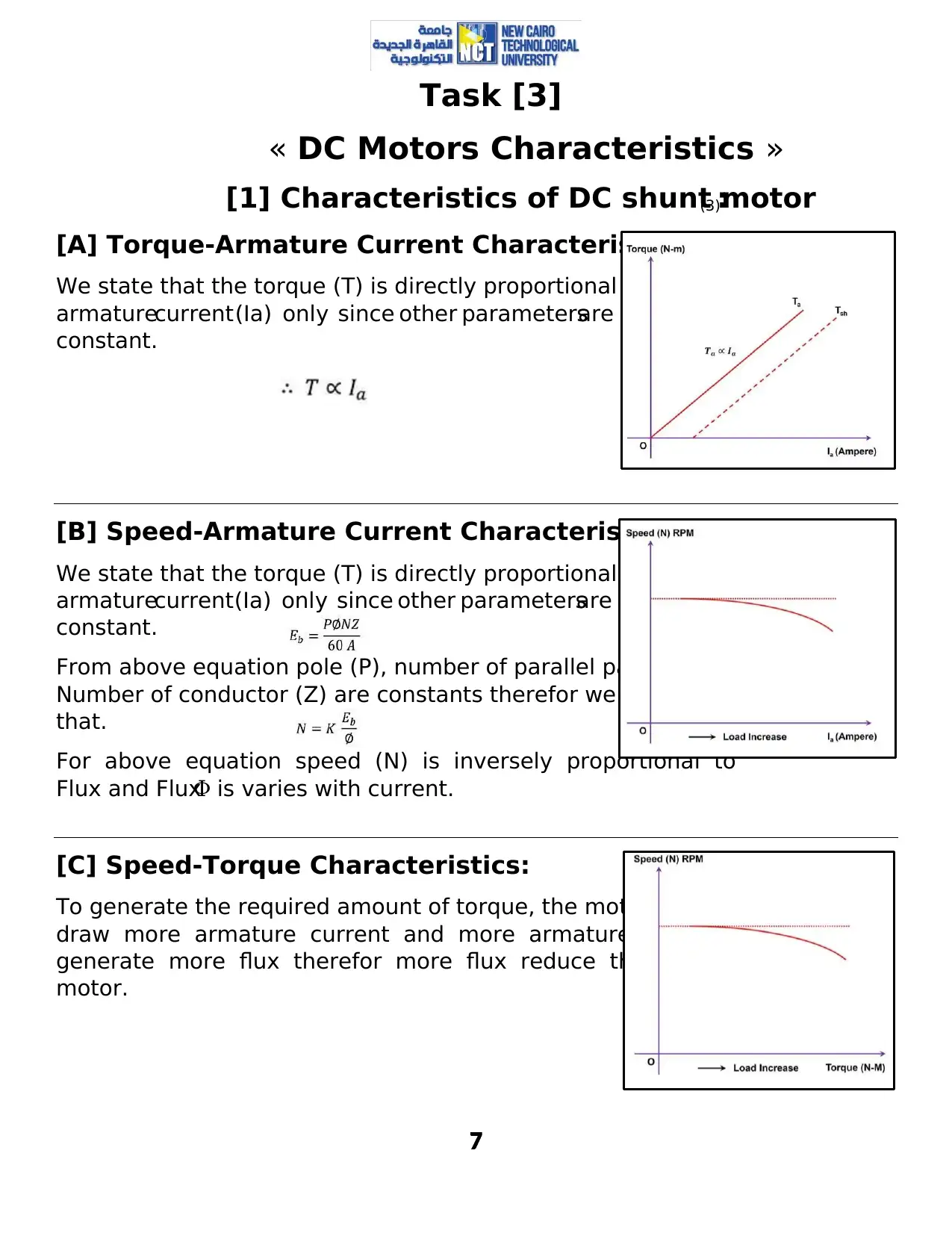
7
Task [3]
« DC Motors Characteristics »
[1] Characteristics of DC shunt motor(3):
[A] Torque-Armature Current Characteristics:
We state that the torque (T) is directly proportional to the
armaturecurrent (Ia) only since other parametersare
constant.
[B] Speed-Armature Current Characteristics:
We state that the torque (T) is directly proportional to the
armaturecurrent(Ia) only since other parametersare
constant.
From above equation pole (P), number of parallel path (A),
Number of conductor (Z) are constants therefor we can write
that.
For above equation speed (N) is inversely proportional to
Flux and FluxΦ is varies with current.
[C] Speed-Torque Characteristics:
To generate the required amount of torque, the motor has to
draw more armature current and more armature current
generate more flux therefor more flux reduce the speed of
motor.
Task [3]
« DC Motors Characteristics »
[1] Characteristics of DC shunt motor(3):
[A] Torque-Armature Current Characteristics:
We state that the torque (T) is directly proportional to the
armaturecurrent (Ia) only since other parametersare
constant.
[B] Speed-Armature Current Characteristics:
We state that the torque (T) is directly proportional to the
armaturecurrent(Ia) only since other parametersare
constant.
From above equation pole (P), number of parallel path (A),
Number of conductor (Z) are constants therefor we can write
that.
For above equation speed (N) is inversely proportional to
Flux and FluxΦ is varies with current.
[C] Speed-Torque Characteristics:
To generate the required amount of torque, the motor has to
draw more armature current and more armature current
generate more flux therefor more flux reduce the speed of
motor.
Paraphrase This Document
Need a fresh take? Get an instant paraphrase of this document with our AI Paraphraser
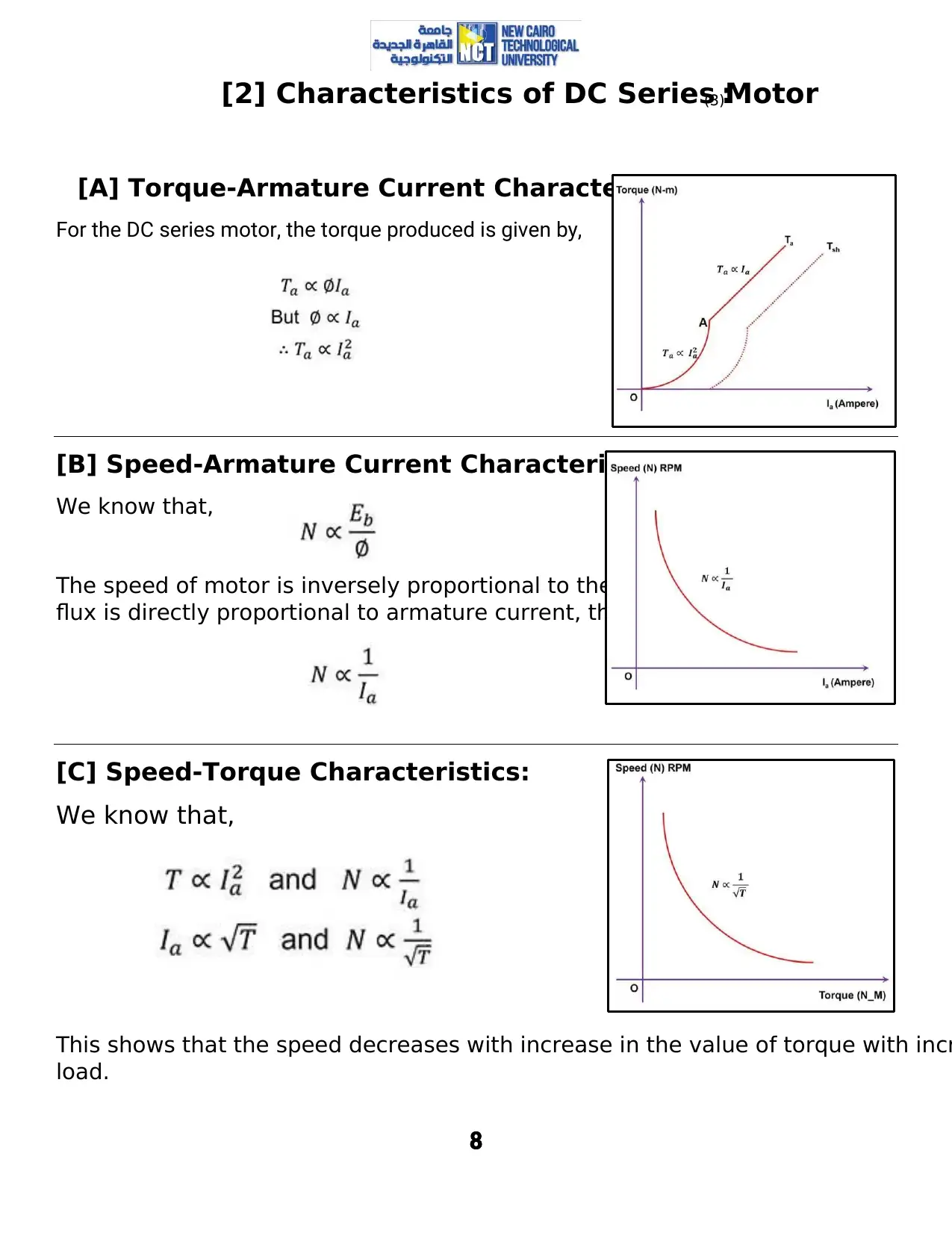
8
[2] Characteristics of DC Series Motor(3):
[A] Torque-Armature Current Characteristic:
For the DC series motor, the torque produced is given by,
[B] Speed-Armature Current Characteristics:
We know that,
The speed of motor is inversely proportional to the flux and
flux is directly proportional to armature current, therefore
[C] Speed-Torque Characteristics:
We know that,
This shows that the speed decreases with increase in the value of torque with incr
load.
[2] Characteristics of DC Series Motor(3):
[A] Torque-Armature Current Characteristic:
For the DC series motor, the torque produced is given by,
[B] Speed-Armature Current Characteristics:
We know that,
The speed of motor is inversely proportional to the flux and
flux is directly proportional to armature current, therefore
[C] Speed-Torque Characteristics:
We know that,
This shows that the speed decreases with increase in the value of torque with incr
load.
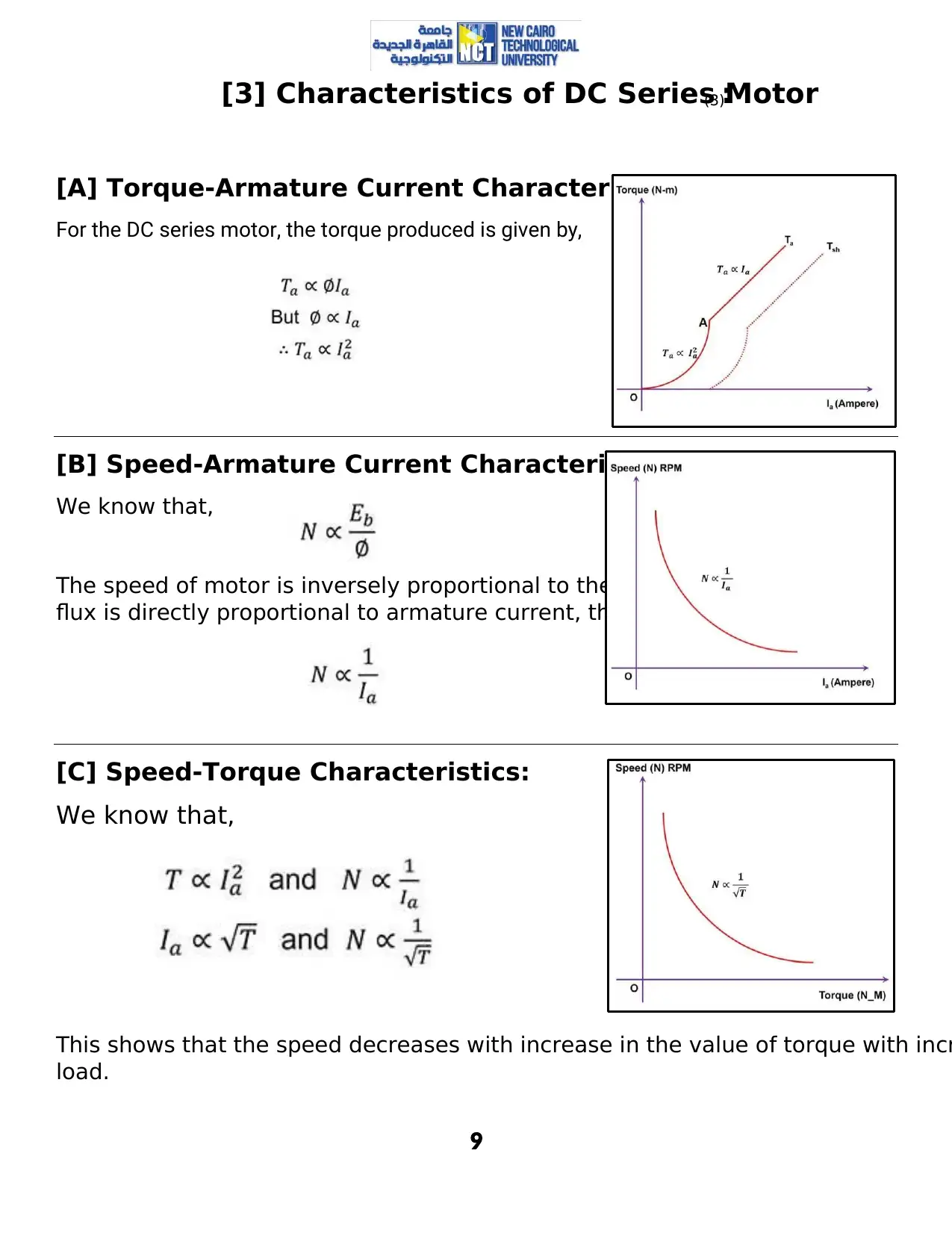
9
[3] Characteristics of DC Series Motor(3):
[A] Torque-Armature Current Characteristic:
For the DC series motor, the torque produced is given by,
[B] Speed-Armature Current Characteristics:
We know that,
The speed of motor is inversely proportional to the flux and
flux is directly proportional to armature current, therefore
[C] Speed-Torque Characteristics:
We know that,
This shows that the speed decreases with increase in the value of torque with incr
load.
[3] Characteristics of DC Series Motor(3):
[A] Torque-Armature Current Characteristic:
For the DC series motor, the torque produced is given by,
[B] Speed-Armature Current Characteristics:
We know that,
The speed of motor is inversely proportional to the flux and
flux is directly proportional to armature current, therefore
[C] Speed-Torque Characteristics:
We know that,
This shows that the speed decreases with increase in the value of torque with incr
load.
⊘ This is a preview!⊘
Do you want full access?
Subscribe today to unlock all pages.

Trusted by 1+ million students worldwide
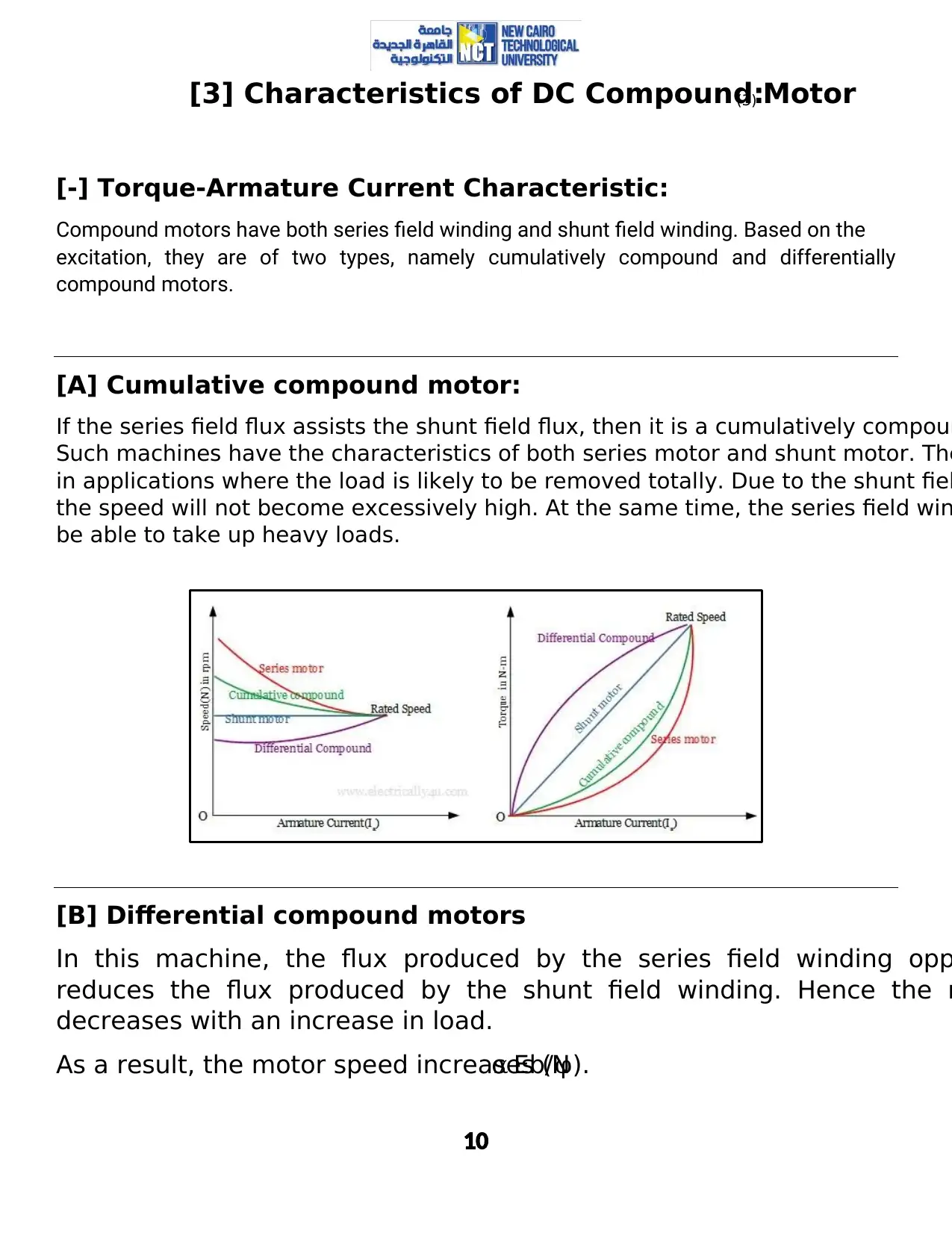
10
[3] Characteristics of DC Compound Motor(3):
[-] Torque-Armature Current Characteristic:
Compound motors have both series field winding and shunt field winding. Based on the
excitation, they are of two types, namely cumulatively compound and differentially
compound motors.
[A] Cumulative compound motor:
If the series field flux assists the shunt field flux, then it is a cumulatively compoun
Such machines have the characteristics of both series motor and shunt motor. The
in applications where the load is likely to be removed totally. Due to the shunt fiel
the speed will not become excessively high. At the same time, the series field win
be able to take up heavy loads.
[B] Differential compound motors
In this machine, the flux produced by the series field winding opp
reduces the flux produced by the shunt field winding. Hence the n
decreases with an increase in load.
As a result, the motor speed increases (Nα Eb/φ).
[3] Characteristics of DC Compound Motor(3):
[-] Torque-Armature Current Characteristic:
Compound motors have both series field winding and shunt field winding. Based on the
excitation, they are of two types, namely cumulatively compound and differentially
compound motors.
[A] Cumulative compound motor:
If the series field flux assists the shunt field flux, then it is a cumulatively compoun
Such machines have the characteristics of both series motor and shunt motor. The
in applications where the load is likely to be removed totally. Due to the shunt fiel
the speed will not become excessively high. At the same time, the series field win
be able to take up heavy loads.
[B] Differential compound motors
In this machine, the flux produced by the series field winding opp
reduces the flux produced by the shunt field winding. Hence the n
decreases with an increase in load.
As a result, the motor speed increases (Nα Eb/φ).
Paraphrase This Document
Need a fresh take? Get an instant paraphrase of this document with our AI Paraphraser
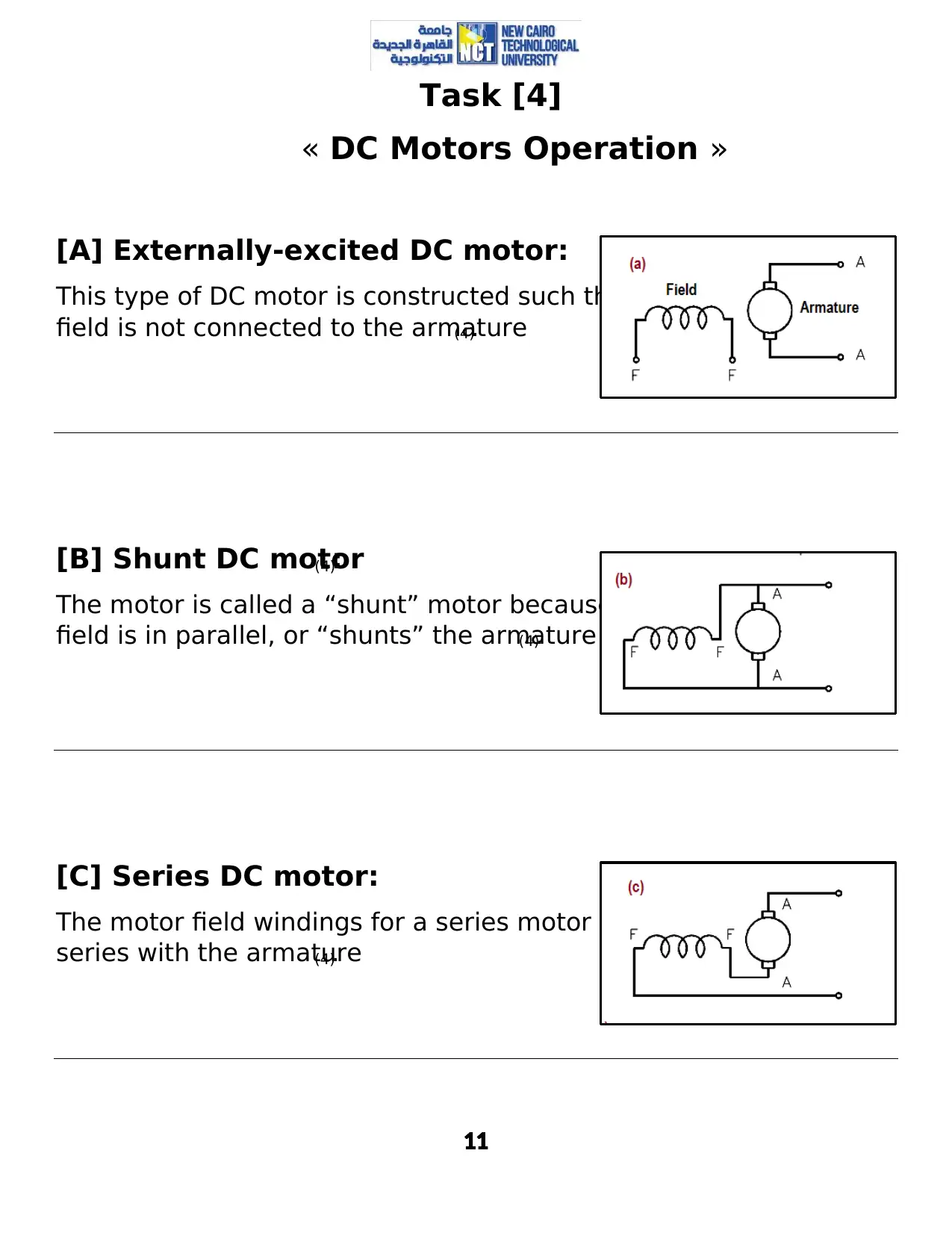
11
Task [4]
« DC Motors Operation »
[A] Externally-excited DC motor:
This type of DC motor is constructed such that the
field is not connected to the armature(4).
[B] Shunt DC motor(4):
The motor is called a “shunt” motor because the
field is in parallel, or “shunts” the armature(4).
[C] Series DC motor:
The motor field windings for a series motor are in
series with the armature(4).
Task [4]
« DC Motors Operation »
[A] Externally-excited DC motor:
This type of DC motor is constructed such that the
field is not connected to the armature(4).
[B] Shunt DC motor(4):
The motor is called a “shunt” motor because the
field is in parallel, or “shunts” the armature(4).
[C] Series DC motor:
The motor field windings for a series motor are in
series with the armature(4).
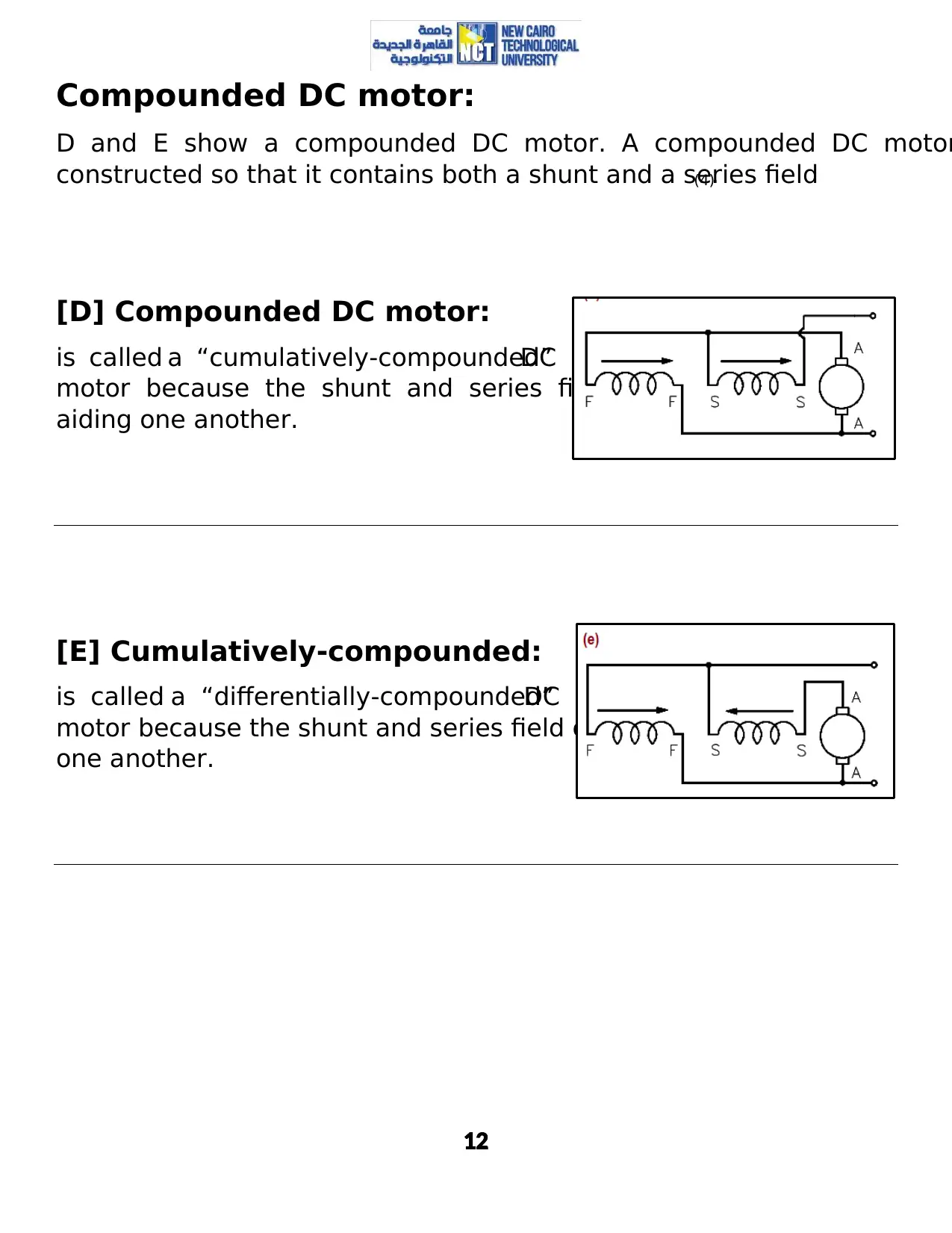
12
Compounded DC motor:
D and E show a compounded DC motor. A compounded DC motor
constructed so that it contains both a shunt and a series field(4).
[D] Compounded DC motor:
is called a “cumulatively-compounded”DC
motor because the shunt and series fields are
aiding one another.
[E] Cumulatively-compounded:
is called a “differentially-compounded”DC
motor because the shunt and series field oppose
one another.
Compounded DC motor:
D and E show a compounded DC motor. A compounded DC motor
constructed so that it contains both a shunt and a series field(4).
[D] Compounded DC motor:
is called a “cumulatively-compounded”DC
motor because the shunt and series fields are
aiding one another.
[E] Cumulatively-compounded:
is called a “differentially-compounded”DC
motor because the shunt and series field oppose
one another.
⊘ This is a preview!⊘
Do you want full access?
Subscribe today to unlock all pages.

Trusted by 1+ million students worldwide
1 out of 15
Related Documents
Your All-in-One AI-Powered Toolkit for Academic Success.
+13062052269
info@desklib.com
Available 24*7 on WhatsApp / Email
![[object Object]](/_next/static/media/star-bottom.7253800d.svg)
Unlock your academic potential
Copyright © 2020–2025 A2Z Services. All Rights Reserved. Developed and managed by ZUCOL.





